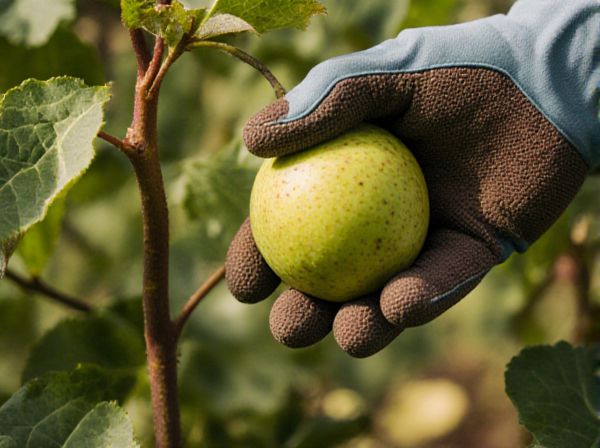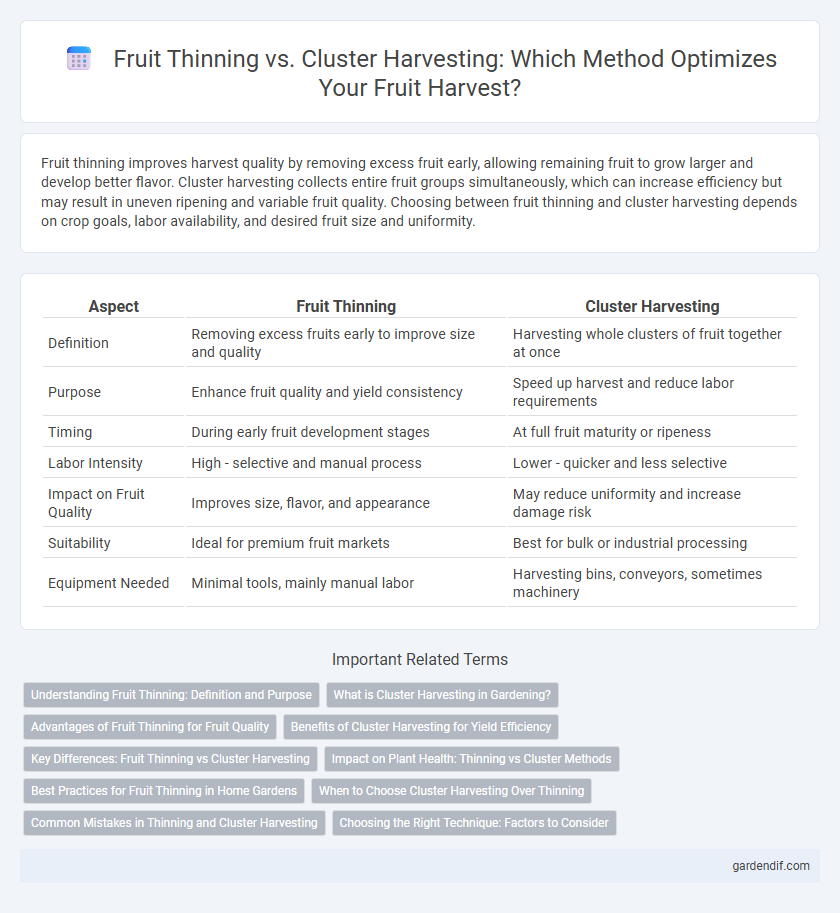
Fruit thinning vs cluster harvesting Illustration
Fruit thinning improves harvest quality by removing excess fruit early, allowing remaining fruit to grow larger and develop better flavor. Cluster harvesting collects entire fruit groups simultaneously, which can increase efficiency but may result in uneven ripening and variable fruit quality. Choosing between fruit thinning and cluster harvesting depends on crop goals, labor availability, and desired fruit size and uniformity.
Table of Comparison
| Aspect | Fruit Thinning | Cluster Harvesting |
|---|---|---|
| Definition | Removing excess fruits early to improve size and quality | Harvesting whole clusters of fruit together at once |
| Purpose | Enhance fruit quality and yield consistency | Speed up harvest and reduce labor requirements |
| Timing | During early fruit development stages | At full fruit maturity or ripeness |
| Labor Intensity | High - selective and manual process | Lower - quicker and less selective |
| Impact on Fruit Quality | Improves size, flavor, and appearance | May reduce uniformity and increase damage risk |
| Suitability | Ideal for premium fruit markets | Best for bulk or industrial processing |
| Equipment Needed | Minimal tools, mainly manual labor | Harvesting bins, conveyors, sometimes machinery |
Understanding Fruit Thinning: Definition and Purpose
Fruit thinning is the agricultural practice of selectively removing immature or excess fruit to improve the quality and size of the remaining produce. This method optimizes resource allocation, enhances air circulation, and reduces disease risk, leading to better yield and market value. Unlike cluster harvesting, which involves collecting entire fruit clusters at once, fruit thinning targets individual fruits for precise crop management.
What is Cluster Harvesting in Gardening?
Cluster harvesting in gardening refers to the practice of picking whole bunches or groups of fruits simultaneously instead of individual fruits, enhancing efficiency and reducing labor costs. This method is commonly applied in crops like grapes, tomatoes, and cucumbers, where fruits grow in tightly packed clusters, allowing for faster collection during peak ripeness. Cluster harvesting helps maintain fruit quality by minimizing handling damage and supports better post-harvest processing for commercial production.
Advantages of Fruit Thinning for Fruit Quality
Fruit thinning enhances fruit quality by improving size uniformity and increasing sugar concentration, which leads to better taste and market value. It reduces competition for nutrients and sunlight among developing fruits, resulting in higher firmness and color intensity. This practice also decreases the incidence of diseases and fruit drop, ensuring a more consistent and premium harvest.
Benefits of Cluster Harvesting for Yield Efficiency
Cluster harvesting improves yield efficiency by enabling simultaneous collection of fruit clusters, reducing labor time and minimizing crop loss compared to individual fruit thinning. This method enhances fruit quality through uniform ripening and decreases mechanical damage during harvest. Efficient cluster harvesting supports higher overall productivity and optimizes resource utilization in commercial orchards.
Key Differences: Fruit Thinning vs Cluster Harvesting
Fruit thinning involves selectively removing excess fruits to improve the size and quality of the remaining produce, enhancing overall yield and reducing resource competition. Cluster harvesting, on the other hand, refers to picking entire fruit clusters at one time, often used for crops like grapes to maintain uniform ripeness and simplify collection. The key differences lie in their timing and purpose: fruit thinning occurs during early growth stages to optimize fruit development, while cluster harvesting is a post-maturity practice aimed at efficient gathering and processing.
Impact on Plant Health: Thinning vs Cluster Methods
Fruit thinning reduces the number of fruits per tree, allowing remaining fruits to receive more nutrients and sunlight, which improves overall plant health and fruit quality. Cluster harvesting involves removing entire bunches, which can stress the plant less but may lead to uneven ripening and increased susceptibility to disease if clusters are left to overgrow. Thinning promotes balanced growth and reduces the risk of branch breakage, while cluster harvesting can conserve labor but requires careful timing to maintain plant vigor.
Best Practices for Fruit Thinning in Home Gardens
Fruit thinning in home gardens enhances fruit size and quality by reducing competition among developing fruits, leading to better light penetration and air circulation. Best practices include removing excess fruitlets early in the season, ideally when they are pea-sized, to prevent tree stress and encourage optimal nutrient allocation. Consistent monitoring and timely thinning promote healthier trees and improve overall harvest yields compared to cluster harvesting, which can result in smaller, less uniform fruits.
When to Choose Cluster Harvesting Over Thinning
Cluster harvesting is preferred when uniform fruit size and consistent ripeness are important, especially in grape production for winemaking. It reduces labor costs by harvesting entire clusters at once, making it ideal for large-scale operations with limited manpower. Fruit thinning is better suited for improving individual fruit quality, but cluster harvesting accelerates the process and maintains balanced yields in commercial vineyards.
Common Mistakes in Thinning and Cluster Harvesting
Common mistakes in fruit thinning include uneven spacing that reduces fruit quality and excessive removal leading to lower yields. In cluster harvesting, improper timing often causes premature fruit drop or uneven ripening, affecting overall quality. Neglecting to adjust thinning and harvesting techniques based on fruit variety and growth stage frequently results in suboptimal crop performance.
Choosing the Right Technique: Factors to Consider
Choosing between fruit thinning and cluster harvesting depends on orchard size, fruit variety, and desired fruit quality. Fruit thinning improves air circulation and fruit size by removing excess fruits early, reducing disease risks and enhancing market value. Cluster harvesting is efficient for high-volume production but may compromise uniformity and fruit maturity, affecting overall quality and post-harvest shelf life.
Fruit thinning vs cluster harvesting Infographic

 gardendif.com
gardendif.com